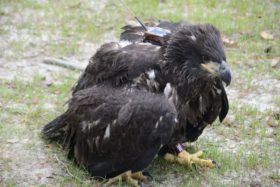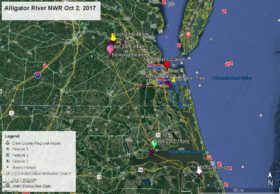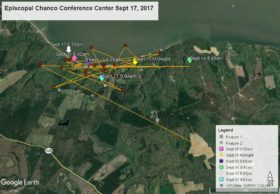Dr Watts Response Re: March 31 Eaglet Banding at NBG
Azalea Remains at Fish Research Station
March 31, 2010Azalea Still At Tidewater Research Station March 31
April 1, 2010 You can click on this link – Bot_gardens_letter – or read the letter below from Dr Bryan Watts (they are both the same).
——————————————————
I wanted to thank all of those who came out to the Norfolk Botanical Garden to the eagle banding event today and all those who tuned in online. I continue to be thrilled and amazed by the number of people monitoring this pair and their broods. In a time with so many distractions, the attention given this pair speaks a great deal about how much we as a global society value wildlife. What a fantastic opportunity that has been provided by the Norfolk Botanical Garden, the Virginia Department of Game and Inland Fisheries, WVEC, Nuckols Tree Care and the other partners to see the intricate and private lives of this spectacular species. It is a privilege to work with them.
The Center for Conservation Biology conducts 30-40 research projects per year focused on birds of conservation concern. We have banded hundreds of eagles and tens of thousands of birds of many species. We have worked toward the recovery of bald eagles in the Chesapeake Bay for more than 40 years and have seen the population in Virginia recover from less than 30 pairs to more than 650 this year. I am one of the lucky ones who has been able to work on more than 50 eagle projects, spending thousands of hours in planes and boats surveying them, handling birds of all ages and banding many, many broods. Even so, I was taken by surprise that two of the chicks were not of banding size today, a clear contradiction to my message just a couple of days ago. Though this may seem on the surface to be a concern, the chicks will be fine and I find this truly fascinating.
The chicks today were 21 days old (1,303 grams), 20 days old (980 grams), and 18 days old (796 grams). This is a typical stagger for a 3-chick brood. Three chicks are the maximum brood size for bald eagles and due to the time difference in hatching the first-hatched chick has quite a head start that it maintains often into the fifth or sixth week. Adults typically are unable to provide the same resources per chick for all three chicks that they can for one or two chick broods and the deficit is mostly borne by the younger chicks resulting in slower growth rates.
Over the past decade we have worked with many broods on the tributaries of the lower Chesapeake Bay. These are some of the most productive waters for eagles in North America. They support some of the highest breeding densities on the continent, the largest average brood sizes, and the fastest growth rates. We have measured many eaglets 15-20 days old and none have been less than 1,000 grams. Most chicks that are 20 days old are more than 2,000 grams and are of perfect banding size. Between 15 and 40 days of age these chicks have an average daily weight gain of 150 grams. The average weight for 15-day old chicks has been 1,350 grams. This is higher than the 21-day old chick today and nearly twice the weight of the youngest chick. Note that the chicks today were perfectly healthy. They are simply growing at a slower rate than those of the lower Chesapeake.
We have no growth data from the outer coastal areas including the Delmarva Peninsula and Lower Tidewater. The difference between this brood and the broods of the lower tributaries lead me to misjudge the early banding date but also invites new research questions. We need more information on the pairs breeding on the outer coastal fringe for comparison. We will measure these chicks again when we return later in the spring to deploy a transmitter. These chicks and others to follow will add to our growing understanding of the ecology of this magnificent species in the hope that it will improve their management in the years to come.
Sincerely,
Bryan D. Watts, Ph.D.
Mitchell A. Byrd Professor of Conservation Biology
Director, Center for Conservation Biology
College of William and Mary




10 Comments
Thank you Dr. Watts.
This is my second year watching the eagles and I applaud you and your team for the exceptional efforts to bring this incredible experience to the world. It really means so much to all of us.
Dr Watts – I understand that some have voiced questions and concerns regarding the timing of the banding, and I find it refreshing that people care enough about these wild creatures to want to protect them so fiercly. None, however, could be more caring than you and your team of experts who have studied and promoted the recovery of this species for many years. I am very happy to have been able to attend today’s event and to witness such devotion by you, Reese, Stephen and Libby. Thank you for making it possible for future generations to enjoy these breathtaking birds.
Thanks for all you all do for these magnificant birds. Today was truly a moving experience. I’m so glad to have been able to come
I was one of the people who expressed concerns about banding the eaglets so soon. I realize that you do a fantastic job, and that you know more about this than I do, but after what happened after the banding yesterday, one eaglet too small, second eaglets’ bands coming off in the nest, I still can’t help but wonder why you did this so quickly instead of waiting until they were about a month old, as was the case in 2007 and 2009.
Because of this happening, will you wait next year until the eaglets are about a month old?
Again, I love what you do…I was just concerned.
Thank you.
Dr Watts – misjudging – is OK. Everything can’t be perfect all the time. I love everything that ALL of you do for us as well our our beautiful Eagles. I look forward to getting to see it all again with a better outcome for you.
A big thank you to YOU, Reese, Libby and Stephen for everything you have given US – the viewers of the cam. I have almost learned too many new things this year !!! Great JOB all of you.
Dr. Watts, thank you for your kind and humble nature. You mention variability. Indeed, and thankfully, there is diversity based on adaptation in nature. I also believe circumstances such as weather played a role in the growth variation – not predictable. With most animals, early intervention seems to be less traumatic and seemed a worthy effort in this case, too. Thank you for everything you folks are doing.
Dr Watts – thank you for your explanation of the reasoning behind the time chosen for banding. I truly understand the variables involved here…and it’s great to know that this opportunity provides more insight into these magnificent birds. Do you know if the lone eaglet (Buddy – avian pox eaglet) from 2008 was smaller or larger than this years brood when he was removed from the nest? Being the only eaglet at the time, would this have made his weight higher than average for his age? Thanks for all you are doing for this species.
Paula – When the 2008 eaglet was removed from the nest our concern was soley the growth on its upper mandible. The VA State Veternarian was present and neither he nor any one else knew what the growth was for certain. Even the medical staff at the Wildlife Center of Virginia with their many years of experience had never seen anything like it and it took lab tests to determine that it was avian pox. We did not therefore at the time take the measurements that would under normal circumstances have been taken.
I look forward each year to watching these eagles, and appreciate what is being done to ensure the continuing recovery of this beautiful bird. Do you know of any research, eagle cam, etc. in North Carolina? I live in the Piedmont Triad of NC and am curious about the population of eagles in this state.
Thank you for the information, Reese.